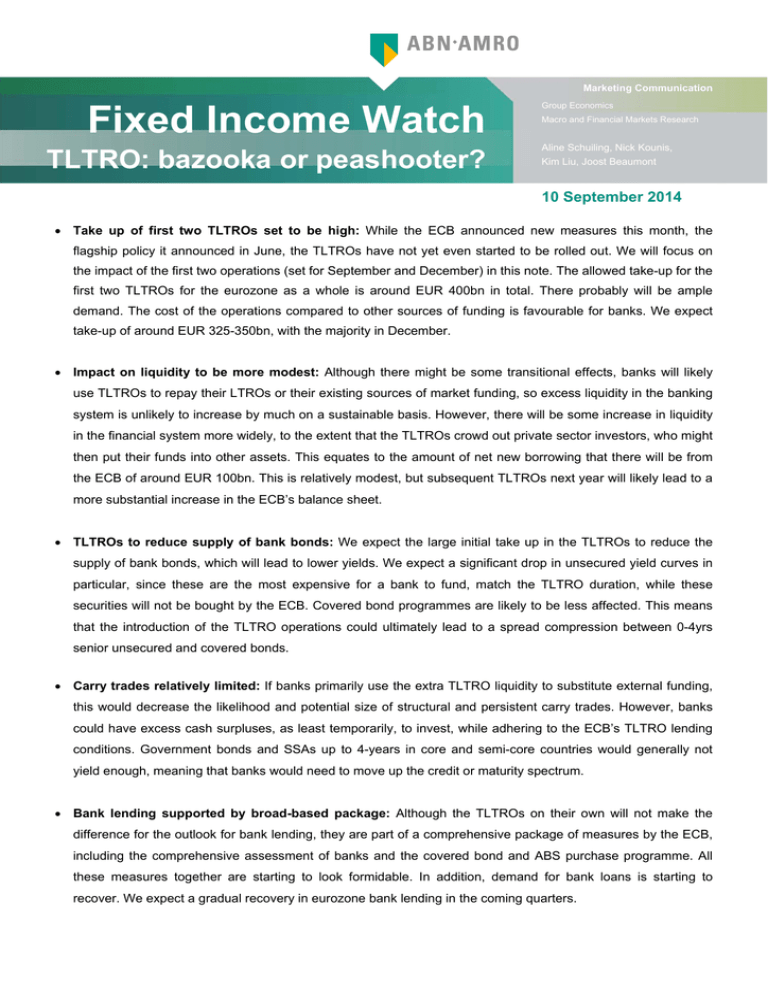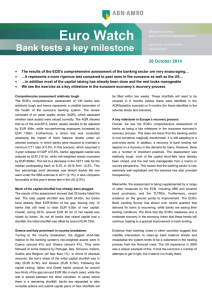
Marketing Communication
Fixed Income Watch
TLTRO: bazooka or peashooter?
Group Economics
Macro and Financial Markets Research
Aline Schuiling, Nick Kounis,
Kim Liu, Joost Beaumont
10 September 2014
Take up of first two TLTROs set to be high: While the ECB announced new measures this month, the
flagship policy it announced in June, the TLTROs have not yet even started to be rolled out. We will focus on
the impact of the first two operations (set for September and December) in this note. The allowed take-up for the
first two TLTROs for the eurozone as a whole is around EUR 400bn in total. There probably will be ample
demand. The cost of the operations compared to other sources of funding is favourable for banks. We expect
take-up of around EUR 325-350bn, with the majority in December.
Impact on liquidity to be more modest: Although there might be some transitional effects, banks will likely
use TLTROs to repay their LTROs or their existing sources of market funding, so excess liquidity in the banking
system is unlikely to increase by much on a sustainable basis. However, there will be some increase in liquidity
in the financial system more widely, to the extent that the TLTROs crowd out private sector investors, who might
then put their funds into other assets. This equates to the amount of net new borrowing that there will be from
the ECB of around EUR 100bn. This is relatively modest, but subsequent TLTROs next year will likely lead to a
more substantial increase in the ECB’s balance sheet.
TLTROs to reduce supply of bank bonds: We expect the large initial take up in the TLTROs to reduce the
supply of bank bonds, which will lead to lower yields. We expect a significant drop in unsecured yield curves in
particular, since these are the most expensive for a bank to fund, match the TLTRO duration, while these
securities will not be bought by the ECB. Covered bond programmes are likely to be less affected. This means
that the introduction of the TLTRO operations could ultimately lead to a spread compression between 0-4yrs
senior unsecured and covered bonds.
Carry trades relatively limited: If banks primarily use the extra TLTRO liquidity to substitute external funding,
this would decrease the likelihood and potential size of structural and persistent carry trades. However, banks
could have excess cash surpluses, as least temporarily, to invest, while adhering to the ECB’s TLTRO lending
conditions. Government bonds and SSAs up to 4-years in core and semi-core countries would generally not
yield enough, meaning that banks would need to move up the credit or maturity spectrum.
Bank lending supported by broad-based package: Although the TLTROs on their own will not make the
difference for the outlook for bank lending, they are part of a comprehensive package of measures by the ECB,
including the comprehensive assessment of banks and the covered bond and ABS purchase programme. All
these measures together are starting to look formidable. In addition, demand for bank loans is starting to
recover. We expect a gradual recovery in eurozone bank lending in the coming quarters.
2
Fixed Income Watch - TLTRO: bazooka or peashooter? - 10 September 2014
Introduction
Will there be a difference between September and
While the ECB announced new measures this month, the
December?
flagship policy it announced in June, the TLTROs have not yet
We expect the take-up to be larger in December than in
even started to be rolled out. With the first of these operations
September. The interest rate on the TLTROs currently is 10bp
approaching later this month, we take a closer look at the likely
higher than the interest rate on the ECBs LTROs (see box
impact. We will focus on the first two operations (set for
below). Therefore, banks that still depend heavily on LTROs
September and December) in this note, and will look more
will probably postpone much of the borrowing to the December
closely at the remaining six (to be spread during 2015) in an
operation. Moreover, some banks will probably prefer to wait
upcoming publication. We assess the likely take-up, the impact
until after the publication of the results of the ECB’s stress test
on liquidity, the effects on bank funding markets and bond
(‘comprehensive assessment’) and AQR in October and the
markets more generally, and bank lending.
results of the take-up in the September TLTRO.
What is the likely take-up of the first two TLTROs?
The allowed take-up for the first two TLTROs (TLTRO1&2) for
the eurozone as a whole is around EUR 400bn in total. There
probably will be ample demand. The lending conditions and
interest rate level compared to other sources of funding are
Figure 1 - Borrowing allowance TLTRO1&2, % GDP
% GDP
5.5
4.5
favourable for banks, particularly for the countries in the
periphery of the eurozone (see below). On top of that, the
3.5
allowed maximum take-up of TLTRO1&2 for most of the
peripheral countries (Spain, Italy, Ireland and Portugal) and for
Belgium is smaller than the amounts they currently have
borrowed from the ECB via the two three-year LTROs, which
2.5
1.5
GR ES PT AT
will expire in January and February 2015. Consequently we
IT
NL
IE
EZ FR
FI
DE BE
Borrowing allowance TLTRO1&2
assume that these countries will take up the full available
amount of TLTRO1&2, of EUR 155bn in total. For the other
countries we have assumed that the take-up will be around
Source: ABN AMRO Group Economics
75% of the total allowance. This means that our estimate for
the total take-up of the September and December TLTROs lies
Box: Technical details and modalities of the TLTROs
in a range of EUR 325-350bn.
The ECB will conduct eight targeted longer-term refinancing
Table 1 - Borrowing allowance TLTRO 1&2
operations (TLTROs). According to the ECB these are
designed to ‘enhance the functioning of the monetary policy
EUR bn
Country
Allowed take-up TLTRO1&2
Current LTROs
transmission mechanism by supporting lending to the real
(end-July 2014)
economy’. They will provide banks with term funding up to four
years (all TLTROs mature in September 2018). The interest
Germany
95
16
France
77
36
Italy
75
159
Spain
54
134
Netherlands
29
5
Austria
15
6
18 September and 11 December, respectively). The borrowing
Belgium
10
14
allowance of TLTRO1&2 will be calculated on the basis of the
Greece
10
1
outstanding amounts of loans to non-financial corporations and
Portugal
8
32
households
Ireland
8
16
purchase). The total allowance for TLTRO1&2 equals 7% of
rate on the TLTROs will be fixed at the level of the ECB’s refi
rate at the time of the TLTRO+10bp (currently 0.15%).
TLTRO1&2: The first two TLTROs (TLTRO1&2) will be
conducted in September and December 2014 (allotment date
(excluding loans to
households
for
house
the outstanding amount of these loans at end-April 2014.
Eurozone
398
381 (Sep 5)
Source: ECB, national central banks, ABN Amro Group Economics
TLTRO 3-8: In addition, six quarterly TLTROs will be
conducted, starting in March 2015 and ending in June 2016.
3
Fixed Income Watch - TLTRO: bazooka or peashooter? - 10 September 2014
The extra borrowing allowance of these six TLTROs will be
because some private sector investors will be crowded out.
based on net lending to the non-financial private sector (excl.
The increase in liquidity will be equal to the net new funds of
mortgages) between the end of April 2014 and the reference
EUR 100bn. This is relatively modest balance sheet expansion
month of the relevant TLTRO. In case this amount of net
compared to, for instance, the size of asset purchase
lending is larger than a specified benchmark, a maximum
programmes by the Fed, BoE and BoJ. For instance, the Fed’s
amount of three times the difference between the benchmark
QE-2 programme would be equivalent to EUR 400bn.
and actual net lending can be borrowed. The benchmark for
However, subsequent TLTROs next year will likely lead to a
banks that have expanded net lending during the twelve
more substantial increase in the ECB’s balance sheet.
months up to 30 April 2014 is set at zero. The benchmark for
banks that have reduced net lending during the twelve months
Figure 2 - Excess liquidity and interbank rates
up to 30 April 2014 will be calculated by extrapolating the
Bp
change in net lending during this twelve-months period until
April 2015 (i.e. the benchmark declines). After April 2015, the
benchmark will also be set at zero.
EUR bn
800
40
20
600
0
-20
Mandatory and voluntary early repayment: If net lending by
-40
a bank is below the benchmark in the period from 1 May 2014
-60
to 30 April 2016, the bank will have to repay all TLTROs in full
-80
on 29 September 2016. Moreover, if a bank’s extra borrowings
-100
in TLTRO3-8 exceed the limit determined by the benchmark it
has to repay the difference on 29 September in a mandatory
400
200
0
09
10
11
EONIA minus refi rate (lhs)
12
13
14
Excess liquidity (rhs)
repayment. Two years after each TLTRO, banks have the
option to voluntary repay the allotted amounts in part or in full
at a six-monthly frequency.
Source: Thomson Reuters Datastream, ABN AMRO Group Economics
Are there implications for interbank rates?
How will the TLTROs impact liquidity?
The short answer is no. Over the last few years, interbank
The impact on the TLTROs on liquidity is not straightforward.
rates have been driven by the level of the ECB’s policy rates,
The large take-up we expect in the first two TLTROs
both current and expectations of where they will be in the
(concentrated in December) is unlikely to manifest itself one-
future, and the amount of excess liquidity in the banking
for-one in either higher liquidity in either the banking system or
system. Given that we do not expect the first two TLTROs to
financial markets more generally. We think that the banks in
increase excess liquidity for any length of time, we do not think
the periphery with large LTROs outstanding will essentially just
that they will have significant effects on interbank rates.
replace their LTROs with TLTROs. That means the net impact
However, excess liquidity will increase due to the ECB
on excess liquidity in the banking system of the TLTRO take-
purchases of ABS and covered bonds. It is not yet clear how
up by peripheral banks will be negligible, though there could be
large these programmes will be, but we think they will total
some short-term transitional effects. The same is true in terms
around EUR 150bn. Given the rate cuts and the rise in excess
of the impact on liquidity in financial markets more generally.
liquidity, we are likely to see a further decline in interbank
rates, though this is not being driven by the TLTROs.
The situation is different for banks, largely in the north of the
eurozone, which have little or no outstanding take-up of
What is the TLTRO advantage in terms of funding costs?
LTROs. These banks will essentially be borrowing net new
The TLTROs will likely result in a decrease in bank funding
funds from the ECB. This means that the central bank’s
needs from markets in coming years. Consequently, this will
balance sheet will expand by roughly EUR 100bn or 5%.
reduce supply of senior unsecured paper and covered bonds,
Despite being a net increase in ECB lending, this is unlikely to
which would add to the negative net supply in these markets.
increase excess liquidity in the banking system. This is
This looks likely because the TLTRO is a relatively cheap
because northern eurozone banks have a strong incentive to
source of funding for banks. The 0.15% banks currently have
replace existing sources of private sector funding (for more on
to pay for TLTRO funding compares to current yields on 2Y
this below) because it is at lower cost. There will however be
senior unsecured paper ranging from 0.38% in the Netherlands
an increase in liquidity in financial markets more generally,
to 1.5% in Ireland, while the range is 0.6% to 4% in the 4Y
4
Fixed Income Watch - TLTRO: bazooka or peashooter? - 10 September 2014
tenor. So, the benefit in the 4Y maturity is between 45 bps and
take up in TLTROs, will fully use the TLTRO in order to replace
385 bps. Needless to say, the yields differ by bank.
their LTRO funding. This is true for banks located in Belgium,
Ireland, Portugal, Spain, and Italy. What is more, banks in
Figure 3 - TLTRO take up minus current LTRO
these countries will be able to substitute LTRO funding with
EUR bn
TLTRO money only partly, leaving a gap that needs to be filled
(assuming that they need to fully refinance LTRO funding).
IT
ES
Table 3 - Yields of covered bonds (%)
PT
IE
Country
BE
Maturity
2Y
3Y
4Y
Germany
0.1
0.15
0.22
NL
France
0.1
0.17
0.24
FR
Italy
0.5
0.54
0.7
Spain
0.4
0.45
0.65
Netherlands
0.1
0.15
0.22
Austria
0.17
0.26
0.36
Belgium
0.1
0.21
0.35
Portugal
0.7
0.8
1.1
Ireland
0.33
0.4
0.55
AT
GR
DE
-100
-50
0
50
100
Source: ABN AMRO Group Economics
Table 2 - Yields of senior unsecured bank debt (%)
Country
Maturity
Source: Bloomberg, ABN AMRO Group Economics
2Y
3Y
4Y
Germany
0.45
0.55
0.7
More new issuance from the periphery?
France
0.5
0.6
0.7
Theoretically, this could imply that these banks will start to
Italy
0.95
1.0
1.15
Spain
0.68
0.88
1.0
Netherlands
0.38
0.46
0.6
Austria
0.8
1.0
1.2
Belgium
0.5
0.68
0.87
3.5
4.0
banks will start to increase issuance of covered bonds/senior
1.65
1.8
unsecured debt. Partly because they increasingly want to
Portugal
Ireland
1.5
Source: Bloomberg, ABN AMRO Group Economics
issue more senior unsecured debt or covered bonds to fill this
gap, although it is also well possible that they will switch to
MRO funding. In case of the latter, the impact on other funding
sources will be zero. However, we do not expect that these
banks will fully turn to MRO funding, as this is short-dated
funding rather than term funding. As a result, we think these
prove that they have access to capital markets, but primarily
due to the favourable funding conditions and the ECB’s
The advantage versus covered bonds is less pronounced. In
the periphery, banks can also in this case raise cheaper
funding using the TLTRO, especially in the longer maturities.
However, for (soft)-core banks, there is only an advantage
from a 3Y maturity. Overall (and not surprisingly), the
advantage is bigger for peripheral banks than those from the
(soft)-core. But given that covered bonds generally carry a
maturity of 5Y or longer, it is clear that there is a big incentive
for all banks to participate in the TLTRO from a funding cost
perspective.
What will be the impact on bank funding needs?
We can estimate the impact of the TLTRO on bank funding
needs using our assumptions of the take up in the TLTROs
(see above). We expect that the banks that currently have a
larger amount outstanding in LTROs than they can potentially
covered bond purchase programme. As such, supply of senior
debt, and (especially) covered bonds, might well increase from
the periphery (and Belgium).
And less from the core?
Looking at banks in the (semi) core countries, we estimate that
their take up in the TLTRO will exceed that of the current
amounts outstanding in the LTRO. As a result, we expect that,
on balance, these banks will reduce funding on the wholesale
markets, reducing issuance of senior unsecured debt as well
as covered bonds.
In total, we estimate that banks in the Netherlands, Germany,
France, and Austria, will take up roughly EUR 160bn in the
TLTROs, replacing around EUR 60bn of LTRO money, leaving
a surplus of roughly EUR 100bn. Bloomberg data shows that
banks in these countries will face around EUR 510bn in
5
Fixed Income Watch - TLTRO: bazooka or peashooter? - 10 September 2014
redemptions of senior unsecured bonds, covered bonds, and
unsecured debt as well as covered bonds to narrow more
government guaranteed bonds next year and in 2016. If we
sharply in these countries than in the periphery.
take this as a benchmark, this year’s TLTROs will cover
around 20% of total bank debt redemptions in 2015 and 2016.
However, there are also factors working in the opposite
Graph 5 shows the breakdown by country, revealing that in our
direction. First of all, supply in the core countries will decline,
base case, almost 30% of redemptions of Dutch and French
which forces investors to put their money to work somewhere
banks (in 2015 and 2016) will be covered by TLTRO funding.
else. The periphery is then an attractive destination, especially
This is a significant amount, but still does not imply that issuers
when taking into account investors’ search for yield, which we
will stay away from capital market funding altogether. They will
expect to intensify further on the back of the ECB actions.
only need less of it.
Ultimately, we think that the search for yield will dominate. This
suggests that spreads of covered bonds as well as senior
unsecured debt are likely to continue to tighten in both the
Figure 4 - Funding needs peripheral banks
(semi) core and even more so in the periphery, with
EUR bn
unpleasant surprises from the AQR being a main risk factor.
160
140
120
100
80
60
40
20
0
Will there be a direct impact on bank bonds?
The decline in supply of bank bonds will lead to lower yields.
We expect a significant drop of unsecured yield curves in
particular, since these are the most expensive for a bank to
fund and match the TLTRO duration, although from a historical
point of view, senior funding is currently relatively cheap.
BE
IR
PT
Deficit between LTRO and TLTRO
ES
IT
Bank debt redemptions 2015/16
Covered bond programmes are likely to be less affected
(although we would still expect yields to go down, not least due
to the ECB’s buying programme), because they are cheaper
funding than unsecured bonds and their maturity is generally
Source: Bloomberg, ABN AMRO Group Economics
longer than that of the TLTRO. This means that the
introduction of the TLTRO operations could ultimately lead to a
Figure 5 - Surplus funding versus redemptions 2015/16
spread compression between 0-4yrs senior unsecured and
covered bonds.
% (share in redemptions)
35%
On the flip side, in the event that supply will decrease and
30%
especially the short end of the unsecured bond curve will
25%
flatten, other investors who usually invest in these assets will
20%
be crowded out. As a result, these investors should decide
15%
between the next three alternatives in their search for yield;
10%
move up the unsecured yield curve, move up the credit
5%
spectrum to other assets, or buy medium maturing covered
bonds, as they would have become relatively cheap compared
0%
FR
NL
AT
DE
Source: Bloomberg, ABN AMRO Group Economics
to unsecured bonds.
Will the TLTROs lead to carry trades?
If banks will primarily use the TLTRO liquidity to substitute
external funding, this would decrease the likelihood and
Will spreads tighten more in periphery of (semi)-core?
potential size of structural and persistent carry trades.
Overall, our analysis shows that the impact of the TLTROs on
However, this does not mean that the carry trade will vanish,
bank funding needs differs between the peripheral banks and
as banks could have excess cash surpluses, at least
those in the (semi) core. The former will most likely increase
temporarily, and decide to invest in various securities, while
wholesale market funding, while banks in the core are
still adhering to the ECB’s TLTRO lending conditions. Tables 4
expected to reduce capital market funding. As such, supply in
& 5 show the potential carry opportunity across government
the (semi) core will decline versus that in the periphery in
bond and SSA products (for covered and senior, see above)
coming years, which would provide room for spreads of senior
6
Fixed Income Watch - TLTRO: bazooka or peashooter? - 10 September 2014
and the likelihood of carry trades for (soft) core banks and
problems in terms of availability, liquidity and could increase
peripheral banks. We assume that banks would choose to
the riskiness of the carry trade. We therefore assume that
invest their surpluses in asset classes which are close to their
although the carry trade is more profitable in SSA and other
own risk and or country profile.
riskier products, the bulk of the potential excess cash would be
invested in sovereign paper.
If (soft) core banks would have a temporary cash surplus, all of
their domestic government bonds and nearly all of the SSA
Table 5 - Yields of SSAs (%)
assets would not yield enough to provide a positive carry trade.
Country
Opportunities to set up a positive carry trade in SSA territory
Maturity
1Y
2Y
3Y
4Y
0.06
0.17
are very limited and can only be found in the 4Y tenor (note
Stability funds
-0.02
-0.02
that the subclasses Stability funds, Multilateral funds, France
Multilateral
-0.03
-0.04
0.04
0.17
Germany
0.00
0.03
0.04
0.13
France
0.04
-0.06
0.09
and Netherlands are on the breakeven point, while only 4yrs
Austrian SSA are yielding significantly more than 15bps). The
large majority of these banks should move up the credit
spectrum and search for yield in their domestic covered and
senior unsecured markets, which yield more than the cost of
the TLTRO.
Italy
0.58
0.16
1.10
Spain
0.28
0.37
0.60
0.71
Netherlands
0.00
0.03
0.06
0.16
Austria
0.00
0.11
Another option for them would be to move up the maturity
Belgium
curve, but we think that this would be less likely, although this
Portugal
would be viable, as short end covered and senior unsecured
Ireland
paper would be increasingly hard to find. Another alternative
Greece
would be to set up a negative carry trade. The rationale behind
Source: Bloomberg, ABN AMRO Group Economics
0.09
2.17
0.35
0.28
2.40
this is that banks would be willing to pay a premium to secure
term funding, as the TLTRO is considerably cheaper than their
Overall, since yields of short-term government paper are
own sources of covered or unsecured funding. Banks could,
already anchored and investors are constantly hunting for
albeit to a minor extent, still be willing to invest their temporary
yield, we expect that covered and senior unsecured bonds of
excess cash positions in government or SSA bonds.
core countries are the most likely candidates to be used by
(soft) core banks for carry trades. This would re-enforce the
Table 4 - Yields of government bonds (%)
Country
trend of lower yields described above, and see a 3-10yrs
steepening. Peripheral banks will probably stick to their
Maturity
1Y
2Y
3Y
4Y
domestic sovereign bonds due to liquidity and additional risk
Germany
-0.08
-0.06
-0.04
0.00
factors. This would lead to lower yields (especially in the short
France
-0.04
-0.04
0.01
0.07
end), a further tightening of short end peripheral government
Italy
0.23
0.41
0.63
0.78
paper vs core paper and 3-10s steepening on each individual
Spain
0.26
0.26
0.41
0.68
Netherlands
-0.05
-0.05
-0.02
0.07
Austria
-0.06
-0.03
0.01
0.10
Belgium
0.04
-0.04
0.00
0.09
Portugal
0.31
0.53
1.01
1.35
Ireland
0.04
0.00
0.16
0.30
3.15
3.87
Greece
Source: Bloomberg, ABN AMRO Group Economics
Logically, peripheral banks have far more carry trade
opportunities. First of all, they could decide to invest in their
own sovereign paper (SP, IT, PO, IR, GR), as even 2yrs
maturing bonds yield more than the TLTRO cost of funding.
Another choice could be to invest their cash temporarily in
SSA, covered or senior bonds, although this could pose
peripheral government curve.
What will the impact on bank lending be?
Although the TLTROs on their own will not make the difference
for the outlook for bank lending, they are part of a
comprehensive package of measures by the ECB, which is
starting to look formidable. The AQR and stress tests should
increase the transparency of bank balance sheets and lead to
stronger capitalisation where necessary. The ECB is also
launching an ABS purchase programme, which will revive a
key market for bank funding, as well as allowing banks to
remove some assets from their balance sheets. In addition,
demand for bank loans is starting to recover. All this suggests
that eurozone bank lending should gradually recover over the
coming quarters.
7
Fixed Income Watch - TLTRO: bazooka or peashooter? - 10 September 2014
DISCLAIMER
ABN AMRO Bank
Gustav Mahlerlaan 10 (visiting address)
P.O. Box 283
1000 EA Amsterdam
The Netherlands
Tel: +31 20 628 9393
This marketing communication has been prepared by ABN AMRO Bank N.V. or an affiliated company (‘ABN AMRO’) and for the purposes of Directive 2004/39/EC has not been prepared in
accordance with the legal and regulatory requirements designed to promote the independence of research. As such regulatory restrictions on ABN AMRO dealing in any financial instruments
mentioned in this marketing communication at any time before it is distributed to you do not apply.
This marketing communication is for your private information only and does not constitute an analysis of all potentially material issues nor does it constitute an offer to buy or sell any
investment. Prior to entering into any transaction with ABN AMRO, you should consider the relevance of the information contained herein to your decision given your own investment objectives,
experience, financial and operational resources and any other relevant circumstances. Views expressed herein are not intended to be and should not be viewed as advice or as a
recommendation. You should take independent advice on issues that are of concern to you.
Neither ABN AMRO nor other persons shall be liable for any direct, indirect, special, incidental, consequential, punitive or exemplary damages, including lost profits arising in any way from the
information contained in this communication.
Any views or opinions expressed herein might conflict with investment research produced by ABN AMRO.
ABN AMRO and its affiliated companies may from time to time have long or short positions in, buy or sell (on a principal basis or otherwise), make markets in the securities or derivatives of,
and provide or have provided, investment banking, commercial banking or other services to any company or issuer named herein.
Any price(s) or value(s) are provided as of the date or time indicated and no representation is made that any trade can be executed at these prices or values. In addition, ABN AMRO has no
obligation to update any information contained herein.
This marketing communication is not intended for distribution to retail clients under any circumstances.
This presentation is not intended for distribution to, or use by any person or entity in any jurisdiction where such distribution or use would be contrary to local law or regulation.
In particular, this presentation must not be distributed to any person in the United States or to or for the account of any “US persons” as defined in Regulation S of the United
States Securities Act of 1933, as amended.
ABN AMRO is authorised by De Nederlandsche Bank and regulated by the Financial Services Authority; regulated by the AFM for the conduct of business in the Netherlands and the Financial
Services Authority for the conduct of UK business.
Copyright 2014 ABN AMRO. All rights reserved. This communication is for the use of intended recipients only and the contents may not be reproduced, redistributed, or copied in whole or in
part for any purpose without ABN AMRO's prior express consent.









